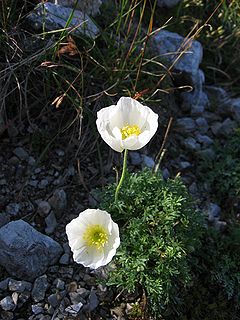Difference between revisions of "Papaver alpinum"
m (→Cultivation: spelling) |
|||
| Line 49: | Line 49: | ||
<gallery> | <gallery> | ||
| − | GelberAlpenmohn.JPG| Yellow alpine poppy (''Papaver rhaeticum'')]] | + | Image:GelberAlpenmohn.JPG| Yellow alpine poppy (''Papaver rhaeticum'')]] |
Image:Upload.png| photo 2 | Image:Upload.png| photo 2 | ||
Image:Upload.png| photo 3 | Image:Upload.png| photo 3 | ||
Revision as of 11:21, 4 February 2010
| Habit | herbaceous
| |
|---|---|---|
| Height: | ⇕ | 5 cm"cm" can not be assigned to a declared number type with value 5. to 20 cm"cm" can not be assigned to a declared number type with value 20. |
| Width: | ⇔ | 20 cm"cm" can not be assigned to a declared number type with value 20. to 40 cm"cm" can not be assigned to a declared number type with value 40. |
| Lifespan: | ⌛ | perennial |
| Origin: | ✈ | Mountains of S. Europe |
| Exposure: | ☼ | sun, part-sun |
|---|---|---|
| Features: | ✓ | flowers |
| USDA Zones: | 5 to 9 | |
| Flower features: | ❀ | orange, yellow, white |
|
Papaver > |
alpinum > |
If this plant info box on watering; zones; height; etc. is mostly empty you can click on the edit tab and fill in the blanks!
Papaver alpinum, the Alpine poppy or Dwarf poppy, is a perennial poppy found in the Alps. This species includes several sub-species, four of which are found in Austria. It forms a basal rosette clump of downy, finely-divided leaves that are gray-green to blue-green in colour. The flowers are borne on single stems.
Read about Papaver alpinum in the Standard Cyclopedia of Horticulture
|
|---|
|
Papaver alpinum, Linn. Alpine Poppy. Low and cespitose perennial, nearly stemless: lvs. glaucous, all radical and petiolate, glabrous or nearly so, 2-3-pinnately parted, the ultimate segms. linear or linear-lanceolate: scapes single or several, the bud ovoid or round-obovoid, usually pilose, nodding; fls. white, fragrant; petals round-obovate, erose, nearly 1 in. long or less: caps, oblong to obovate, strongly ribbed. Alps, Apennines.— The following garden varieties have been offered as of this species, but some of them are probably P. pyrenaicum: albiflorum, album, aurantiacum, flaviflorum, flavum, roseum and rubrum. P. luteum, Hort., belongs here, but P. luteum of the botanists is the Welsh Poppy, Meconopsis cambrica. CH
|
Cultivation
These are quite hardy, withstanding light snow and frost during winter. They like a light, moist soil that is free draining.
Propagation
They can be propagated from root cuttings or seeds.
Pests and diseases
- Do you have pest and disease info on this plant? Edit this section!
Species
Gallery
If you have a photo of this plant, please upload it! Plus, there may be other photos available for you to add.
References
- Standard Cyclopedia of Horticulture, by L. H. Bailey, MacMillan Co., 1963
External links
- w:Papaver alpinum. Some of the material on this page may be from Wikipedia, under the Creative Commons license.
- Papaver alpinum QR Code (Size 50, 100, 200, 500)


